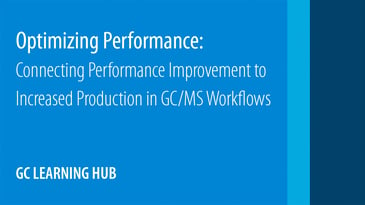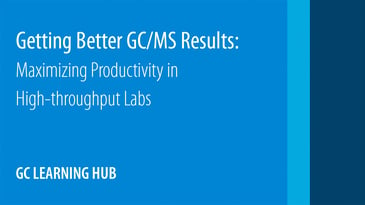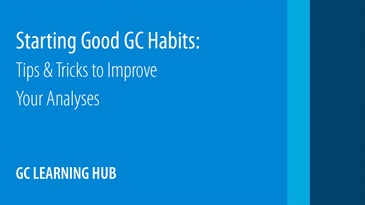
MODULES: 8
RUN TIME: 75 minutes
Gain more understanding on why different consumables are used for different applications, and listen to Agilent Scientists discuss the complexities of the most frequently asked questions they receive. Learn about:
- best practices with GC and GC/MS systems
- why there is not always an easy answer to most GC(MS) questions
Modules
- How Long Should My Liner Last?
- How Long Should My Column Last?
- Where Do Ghost Peaks Come From?
- How Often Should You Tune Your Mass Spectrometer?
- Why Does the Baseline Increase at the End of the Run?
- Why Do Peaks Tail?
- What Happens if My Sample is in Water?
- What Steps Would You Take to Determine the Source of Contamination Within Your Chromatograph?

MODULES: 5
RUN TIME: 75 minutes
Understand how to troubleshoot GC/MS problems through the eyes of an Agilent scientist:
- Learn how to half-split and troubleshoot through problems on a GC/MS
- Learn about GC and MS supplies and columns and how choosing the right supplies can affect the outcome of your analysis…for better or worse!
Modules
- Strategies for Approaching the Problem
- Peak and Baseline Issues
- Correcting Active Sites, Working with Dirty Samples and Backflush
- Troubleshooting Your Detector
- Questions

MODULES: 5
RUN TIME: 50 minutes
This tutorial goes over some columns, liners and supplies that are critical to achieve optimal performance even for low-trace level analysis and deliver consistent reliable results. Learn to:
- Maintaining the GC, MS, carrier gas and rough pumps to maintain (or gain) performance of the GC (and GC/MS) system.
- Set-up your GC(MS) system for success with the optimal supplies and parameters to match the analysis.
Modules
- Selecting the Correct Liner
- Choosing the Correct Column Technology to Maximize Productivity
- Application Examples - DB-5ms Inert
- Capillary Flow Technology Devices - Why, What, Where & How?
- Optimal Conditions for Trace Analysis Using GC/MS and GC/MS/MS

MODULES: 4
RUN TIME: 50 minutes
Watch this tutorial to learn about:
- Tips to replace gas filters, columns and pump oil
- When to do maintenance on the MSD
- Using the best MS parts for your application
- Using the right gain factor and A/D samples for your analysis
- Matching consumables to your analysis, such as columns and liners
Modules
- Considerations for Returning Your GC System to Peak Performance
- Check Points for Ensuring Your GC System is Fully Optimized
- Application Examples — PAH Anaylsis Using Smart Key
- Get the Most Out of Your Mass Spectrometry

MODULES: 6
RUN TIME: 60 minutes
In this tutorial you will learn about remote operation using Smart GCs and understand classic and novel ways to interact with them. Learn about:
- Intuitive operation through a browser user interface
- Remote diagnostics on the GC
- Network capabilities of Smart GCs and how they can can greatly increase the capabilities of daily laboratory operations.
Modules
- Introduction, Definitions and Network Levels
- Ways to Interact Remotely with GC and Agilent System Set-up
- Intelligent GC Systems Explained
- Accessing Help and Information
- Routine Maintenance and Troubleshooting
- Smart Alerts — Usage-driven Instrument Maintenance

MODULES: 5
RUN TIME: 40 minutes
This tutorial goes over simple strategies to speed up analyses with method translator and to help maintain a healthy GC (MS) system longer. Learn about:
- The best columns for GC-MS analysis and how to convert to narrower bore for faster analysis
- Setting up your GC (MS) system for success with the optimal supplies, tools, and strategies for running faster analyses and maintaining a clean system for as long as possible.
Modules
- Maximize Your Throughput with Fritted Liners
- Choosing the Right GC Column to Maximize Productivity
- Increase Throughput with Capillary Column Backflush and Jet Clean
- Make Installation Faster with Self-tightening Nuts
- Smart GCs and Consumables

MODULES: 10
RUN TIME: 45 minutes
Here we’ll review 10 ways to easy GC including:
- Sample overlap to run more samples in less time
- Self-tightening column nuts
- Column smart keys
- Sandwich injections
- A host of other tips to improve your lab life!
Modules
- Gas Clean Filter and Sensor
- Gas Saver
- Autonomous Testing
- Self-tightening Nuts
- Columns with Smart Keys
- Remote Connectivity / Maintenance
- Retention Time Locking
- PSD / Backflush
- Sandwich Injections
- Oven Pillow

MODULES: 6
RUN TIME: 50 minutes
In this tutorial you will learn how to:
- Identify critical GC maintenance needs
- Ensure consistent GC performance
- Monitor chromatography quality, and column and consumables health
- Boost your confidence for DIYing GC maintenance
Modules
- GC Maintenance — When, What & How?
- Early Maintenance Feedback
- Changing Your Split Vent Trap and Other Good Habits
- Case Study — QC, Chemicals Lab
- Case Study — Environmental Lab
- Troubleshooting Starting Points

